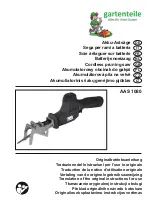
30
31
30
31
3. Loosen the blade lock knob and
move the blade to the maximum
vertical position and tighten the
blade lock knob.
4. Place a combination square on the
table and against the blade (1) to
determine if the blade is 90° to the
table. (Fig. CC)
5. If the blade is not 90° to the table,
loosen or tighten (depending on
whether you are increasing or
decreasing the degrees) the hex
bolt (3) with a 5 mm hex wrench
until you achieve 90°. (Fig. DD)
6. Loosen the blade lock knob and
reset the blade at the maximum
vertical position, then tighten the
blade lock knob.
7. Check again to see if the blade is
90° to the table. If not, repeat step 5.
8. Lastly, check the bevel angle scale.
If the pointer does not read 90°,
loosen the screw holding the
pointer and move the pointer so it
is accurate at 0° and retighten the
pointer screw.
Fig. CC
90°
1
2
45°
45° Stop
1. Disconnect the saw from the power
source.
2. Raise the blade to the maximum
elevation.
3. Loosen the blade lock knob and
move the blade to the maximum
bevel position and tighten the blade
lock knob.
4. Place a combination square on the
table and against the blade (2) to
determine if the blade is 45° to the
table. (Fig. CC)
5. If the blade is not 45° to the table,
loosen or tighten (depending on
whether you are increasing or
decreasing the degrees) the hex
bolt (4) with a 5 mm hex wrench until
you achieve 45°. (Fig. DD)
6. Loosen the blade lock knob and
reset the blade at the maximum
bevel position (45°), then tighten the
blade lock knob.
7. Check again to see if the blade is
45° to the table. If not, repeat step 5.
Fig. DD
3
4
















































